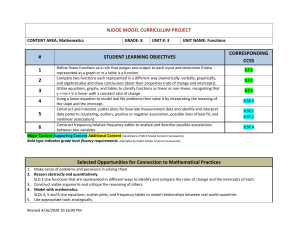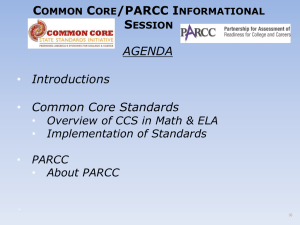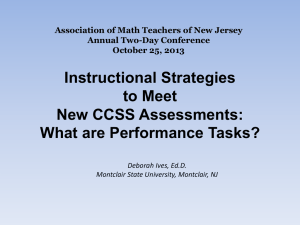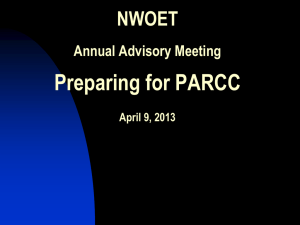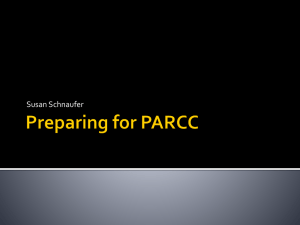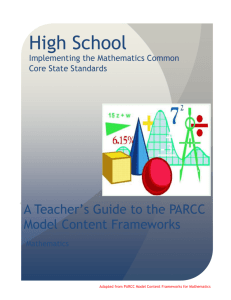MATH Model Content Frameworks
advertisement
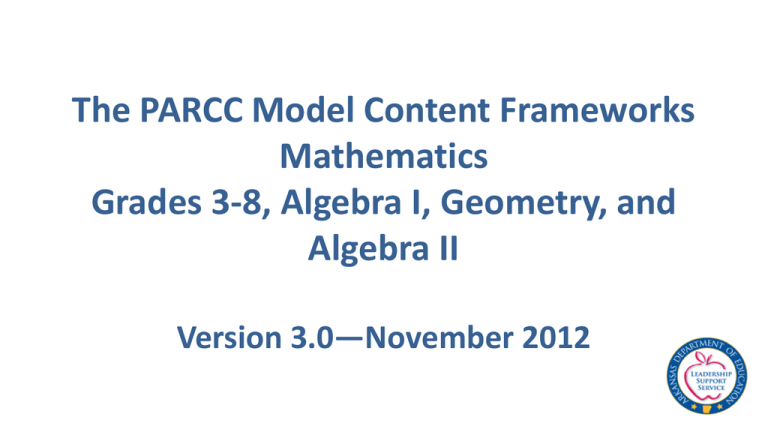
The PARCC Model Content Frameworks Mathematics Grades 3-8, Algebra I, Geometry, and Algebra II Version 3.0—November 2012 Common Core State Standards for Mathematics • 8 Standards for Mathematical Practice – Describe areas of expertise for students at all grade levels – Rest on important processes and proficiencies • Mathematics Content Standards – Grade specific in 3-8 – Domain specific for high school standards Key Shifts in Mathematics • Content Shifts – Big ideas at each grade band • Fluency (K-4) • Algebraic Thinking and Proportional Reasoning (5-8) • Functions and Modeling (9-12) Key Shifts in Mathematics • Instructional Shifts – Teachers should move away from “coverage” toward deeper understanding. – Greater emphasis is placed on the 8 Standards for Mathematical Practice. – Instructional emphasis is placed on natural learning progressions as well as clusters of information. – Discrete bits of information are no longer the strategy for instruction. – Test preparation is no longer the focus of instruction. 4 Approach of the Model Content Frameworks for Mathematics • Analysis of CCSS on how focus, coherence, content and practices all work together • Frame the critical advances in the standards: – Focus and coherence – Content knowledge, conceptual understanding, and expertise – Content and mathematical practices • Grades 3-8; Algebra I, Geometry, Algebra II; Mathematics I, Mathematics II, Mathematics III Purpose and Audience of the Model Content Frameworks Purpose • Inform development of PARCC assessments • Support implementation of the Common Core State Standards Audience • State and local curriculum directors • Teachers and building administrators Purposes for the PARCC Model Content Frameworks • To serve as a bridge between the Common Core State Standards and the PARCC assessments by – Supporting implementation of the Common Core State Standards – Informing development of item specifications and blueprints for the PARCC assessments • To serve as one model for teachers, curriculum directors, and administrators A Model for Curriculum Developers and Teachers • Illustrates one way of organizing the content of the standards over the course of the school year without prescription • Reflects the key shifts in the standards • Provides insight into the development of the PARCC Assessment System • Presents standards in an integrated fashion • Focuses on essential knowledge, skills, and understandings students must develop for college and career readiness Note: The Frameworks are NOT a complete guide for curriculum. What is Different about PARCC’s Development Process? • PARCC states first developed the Model Content Frameworks to provide guidance on key elements of excellent instruction aligned with the Standards. • The Model Content Frameworks informed the assessment blueprint design. So, for the first time. . . • PARCC is communicating in the same voice to teachers as it is to assessment developers! • PARCC is designing the assessments around the exact same critical content the standards expect of teachers and students. An Aligned System Common Core State Standards Model Content Frameworks Model Instructional Lessons/Units PARCC Assessment System CCSS Goal: All Students College and Career Ready • Students will solve problems related to the content at their grade level with connections to the practices. • Students express mathematical reasoning by constructing mathematical arguments and critiques. • Students solve real-world problems engaging particularly in the modeling practice. • Students demonstrate fluency in areas set forth in the Standards for Content in grades 3-6. Key Elements of the Model Content Frameworks • • • • • • • • Examples of Key Advances from Previous Grades Fluency Expectations Examples of Major Within-Grade Dependencies Opportunities for Connections Opportunities for In-Depth Focus Opportunities for Connecting Content and Practices Content Emphasis by Cluster Assessment Limitations Key Advances from Previous Grades • Why? – Diagnostic in Nature – Embedded Assessment of Securely Held Content – Early Intervention to Close Curricular Gaps – Opportunity to Remediate Areas of Concern From Earlier Grades – Opportunity for Vertical Alignment 13 Key Advances from Previous Grades • Grade 5 Example – Students use their understanding of fraction equivalence and their skill in generating equivalent fractions, including fractions with unlike denominators. 14 Key Advances from Previous Grades • Imperative in Order To – Add and Subtract Fractions with Unlike Denominators – Understand Equal Fractions as a Scaling of the Numerator and Denominator – Solidify the Foundation Needed to Perform Operations on Algebraic Fractions (Rational Expressions) 15 Fluency Expectations and Examples of Culminating Standards • Why? – Always Good to Know Where You Are Going – Frames the Key Take-Aways at Each Grade Level – Helps to Prioritize Scope and Sequence 16 Fluency Expectations and Examples of Culminating Standards • Grade 7 Example – Students solve multistep problems posed with positive and negative rational numbers in any form, using tools strategically. 17 Fluency Expectations and Examples of Culminating Standards • How does this help me as a teacher? – Helps me to understand overarching goals of the grade level – Helps me to see the culmination of multiple progressions as well as the integration of math practices and problem solving – Helps me to think of instruction in terms of something other than discrete bits of information 18 Examples of Major Within Grade Dependencies • Why? – Highlights Body of Content Within a Grade Where Conceptual Understanding of One Body of Knowledge Depends on Another Body of Knowledge at the Same Grade Level – Stresses the Need to Organize Coherently 19 Examples of Major Within Grade Dependencies • Grade 6 Example – Equations in the form px=q (6.EE.7) are unknown factor problems and solutions could sometimes be the result of dividing a fraction by another fraction (6.NS.1). 20 Examples of Major Within Grade Dependencies • Outcomes for teachers and students – Thoughtful organization allows teachers to develop and deliver more meaningful lessons and units. – Students are able to use knowledge already mastered to engage in more complex problems. 21 Examples of Opportunities for Connections Among Standards, Clusters, or Domains Why? –Opportunities to Connect Content in Assessments, Curriculum, and Instruction –Stresses the Need to Avoid Checklist Mentality 22 Examples of Opportunities for Connections Among Standards, Clusters, or Domains • Grade 8 Example – Students’ work with proportional relationships, lines, linear equations, and linear functions can be enhanced by working with scatter plots and linear models of association in bivariate measurement data (8.SP.1-3) 23 Examples of Opportunities for Connections Among Standards, Clusters, or Domains • What is the Value? – Excellent opportunity to integrate real world applications as well as mathematical modeling. – Provides opportunities for students to engage in rich mathematical tasks, in turn preparing them for the rigors of the PARCC Assessments. 24 Examples of Opportunities for In-Depth Focus • Why? – Highlights standards that play an important role in the content at a grade level – Frames important considerations such as assessment questions, time devoted to the standard, amount of student practice, etc. 25 Examples of Opportunities for In-Depth Focus • Grade 3 Example – Continuous measurement quantities such as volume and mass are important context for fraction addition. – Students should experience whole number problems involving continuous measurement quantities to help establish foundation for future problems in Grades 4 and 5. 26 Examples of Opportunities for Connecting Mathematical Content and Mathematical Practice • Why? – Happens in the context of solving a problem – Practices interact and overlap with each other – Reminder that content and practices are never really separate when engaging in real and meaningful learning 27 Examples of Opportunities for Connecting Mathematical Content and Mathematical Practice • Grade 8 Examples – Solving an equation requires students to see and make use of structure. – Much of the mathematics in grade 8 lends itself to modeling especially around linear relationships with functions. 28 Content Emphasis By Cluster • Why? – Provided so that curriculum, instruction, and assessment reflect the focus and emphasis of the standards – Separated into Major, Additional, and Supporting clusters 29 Content Emphasis By Cluster • Grade 5 Example – Converting like measurement units within a given measurement system supports computation with decimals. (Metric system) – Major emphasis on performing the operations with supporting content of conversion within a system. 30 High School Frameworks • Divides content into Major, Supporting and Additional clusters • Key Advances from K-8 • Mathematical Practices Related to Course Content • Fluency Recommendations 31 High School Frameworks • The Pathway Summary Table outlines where specific standards are housed. • For standards that are “cross-cutting” or that appear in multiple courses, assessment limitations are also presented. 32 Supporting Programs/Initiatives • • • • • • MDC CGI UBD EQuIP Rubric Arkansas IDEAS Cooperatives and STEM Centers 33 Challenges • • • • • Planning Expectation Content Fear of the Unknown Autonomy and Creativity 34 Rewards • • • • Meaningful Mathematics Greater Conceptual Development In-Depth Focus Greater Student Achievement 35 PARCC’s Fundamental Advance PARCC is designed to reward quality instruction aligned to the Standards, so the assessment is worthy of preparation rather than a distraction from good work. Contact Information Dr. Tracy Tucker tracy.tucker@arkansas.gov Thomas Coy thomas.coy@arkansas.gov Anthony Owen anthony.owen@arkansas.gov Janie Hickman janie.hickman@arkansas.gov 37



